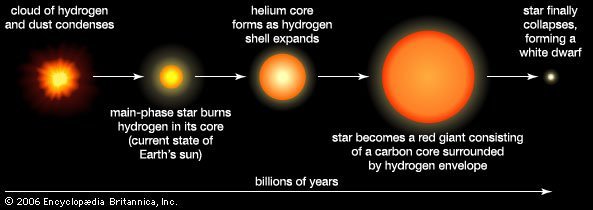The solar lifecycle is like the ultimate cosmic journey, a story of birth, life, and eventual demise, but on a scale so grand it makes our human lifespans seem like mere blinks. So, grab a cup of your favorite beverage, and let's chat about this fascinating celestial saga.
The Beginning
First off, let's talk about where it all begins: the birth of a star, or as astronomers like to call it, stellar formation. Picture this: a vast, cold cloud of gas and dust floating in space, known as a molecular cloud. It's like a cosmic nursery, just waiting for the right conditions to start the process of star-making. Now, something needs to trigger the cloud to collapse – it could be the shockwave from a nearby supernova or just the gentle nudge of gravity doing its thing.As this cloud collapses under its own gravity, things start to heat up, quite literally. The center of this collapsing cloud, known as the protostar, gets hotter and denser. It's like a cosmic pressure cooker, with temperatures and pressures rising to mind-boggling levels. And then, voilà! Nuclear fusion kicks in. This is the moment our protostar graduates to a main-sequence star, like our very own sun. It's like the star's official coming-of-age party, where it starts fusing hydrogen into helium, releasing a tremendous amount of energy. This energy is what lights up the star and what we see as its shining glow.
The Middle
Now, let's talk about the main sequence phase, which is like the star's long, productive middle age. For a star like our sun, this phase lasts about 10 billion years. During this time, the star is relatively stable, just happily converting hydrogen into helium in its core. It's the good life, really. The star is in a state of equilibrium, with the outward pressure from nuclear fusion balancing the inward pull of gravity.
The End
But, as they say, all good things must come to an end. Eventually, the star's hydrogen fuel starts running low. This is where things get dramatic. For a star like our sun, the core contracts and heats up even more, while the outer layers expand and cool down. The star becomes a red giant. Imagine our sun, but swollen to such a size that it could swallow Mercury, Venus, and maybe even Earth. It's like the star's going through a mid-life crisis, trying on a new, much larger look.In the core of the red giant, helium now starts fusing into heavier elements like carbon and oxygen. This phase, however, is much shorter than the main sequence phase. It's like the star is burning the candle at both ends.
Now, for stars like our sun, the end is relatively peaceful. The outer layers of the red giant drift away into space, creating a beautiful shell of gas and dust called a planetary nebula. What's left behind is the core of the star, now a white dwarf. It's like the star has retired, slowly cooling and fading away over billions of years.
But for more massive stars, the finale is more of a grand spectacle. These stars go out with a bang, in a supernova explosion. It's one of the most energetic events in the universe. The core of the star collapses, and the outer layers are blown away in a spectacular explosion. What remains can be a neutron star or, if the star is massive enough, a black hole – the ultimate cosmic enigma.
So, there you have it, the life story of a star. From a cold cloud of gas and dust to a shining beacon in the sky, and eventually, a peaceful white dwarf or a dramatic supernova. It's a cosmic journey of transformation, a testament to the ever-changing nature of the universe. And to think, the atoms that make up everything around us, including ourselves, were forged in the hearts of stars. We're quite literally made of stardust, participants in this grand cosmic cycle. Now, if that's not a thought to ponder over your next cup of coffee, I don't know what is!



Share:
History's Most Significant Eclipses
Why It's Important to Understand Earth's Cryosphere